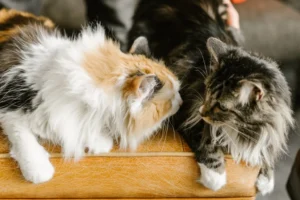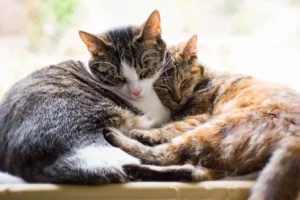Cats and birds have a complex relationship that has puzzled humans for centuries. What is it about birds that draws cats in so irresistibly? Let’s take a closer look at why cats are attracted to birds.
Natural Instincts
Cats are natural-born hunters, with instincts that drive them to stalk and capture prey. This predatory behavior is deeply ingrained in their DNA, stemming from their wild ancestors who relied on hunting for survival. When a cat spots a bird fluttering around, it triggers their hunting instincts, causing them to become fixated on the potential prey.
Cats have sharp senses, including keen eyesight and acute hearing, which help them detect even the slightest movements or sounds made by birds. These predatory instincts are hardwired into their brains, making the sight or sound of a bird an irresistible lure for them. The thrill of the chase and the opportunity to pounce on a bird activates their natural hunting behavior, giving them a rush of adrenaline.
Movement and Sound
The movement and sounds of birds are like magnets to cats, capturing their attention and stirring up their inner predator. Birds’ quick, erratic movements mimic the unpredictable behavior of prey animals, triggering a cat’s instinct to chase and catch them. The fluttering wings and nimble hopping of birds appeal to a cat’s innate desire to pursue and capture moving objects.
Furthermore, the chirping, tweeting, and whistling noises made by birds serve as auditory signals that captivate a cat’s interest. These sounds not only alert cats to the presence of potential prey but also stimulate their hunting instincts. The combination of visual stimuli and auditory cues creates a compelling sensory experience for cats, driving them to engage in their natural hunting behavior.
Key Insight: In addition to movement and sound, the vibrant colors of certain bird species can also attract cats, as bright hues can stimulate their visual senses and enhance the allure of the feathered creatures.
Visual Appeal
Cats are often attracted to birds due to their vibrant colors and unique patterns, which catch the feline eye like a moth to a flame. Birds, with their bright feathers and distinctive markings, are like living artworks that cats can’t resist staring at. Cats are natural hunters, and these visual cues act as a trigger for their primal instincts to pounce and chase.
Exercise and Entertainment
Hunting birds provides indoor cats with both physical exercise and mental stimulation, keeping them active and engaged. Cats are highly intelligent animals that need mental stimulation to prevent boredom and behavioral issues. Chasing birds around the house, even if it’s just a toy bird on a string, helps cats burn off excess energy and satisfy their natural hunting instincts.
- Interactive toys: Find toys that mimic bird movements to keep your cat engaged and active.
- Cat shelves: Install shelves near windows for your cat to perch and watch birds outside, providing both physical and mental stimulation.
- Supervised outdoors time: If possible, take your cat outside on a harness and leash so they can experience the sights and sounds of nature in a safe environment.
Remember, engaging your cat in playful activities that mimic hunting can help satisfy their innate need for stimulation and prevent them from fixating on real birds. Keep your furry friend entertained and exercised to ensure a happy and healthy feline companion.
Stealth and Strategy
Cats are natural-born hunters, and when it comes to birds, they utilize their stealth and cunning strategy to secure their prey. With their keen senses of sight, hearing, and smell, cats can stalk birds quietly and patiently wait for the perfect moment to strike. Their agile bodies and sharp claws give them the advantage in pouncing on unsuspecting birds, making them formidable hunters in the wild.
If you’re a bird owner, it’s essential to take precautions to protect your feathered friends from potential threats posed by cats. Consider placing bird feeders and baths in elevated locations out of reach of prowling felines. Additionally, trimming any overgrown vegetation near your bird’s habitat can eliminate hiding spots for hunting cats. Finally, supervising your birds while they are outside can help prevent any surprise attacks from nearby predators.
Remember, cats are natural predators, and it’s in their nature to hunt. By understanding their stealth and strategy when it comes to birds, you can better protect your avian companions and ensure their safety. Stay vigilant and implement these precautions to create a safe environment for your feathered friends.
Precautions for Bird Owners:
– Place bird feeders and baths in elevated locations.
– Trim overgrown vegetation near bird habitats.
– Supervise birds outside to prevent surprise attacks.
Indoor Enrichment
Cats are natural hunters, and their attraction to birds stems from this instinct. To help satisfy their hunting instincts and reduce their interest in live prey, providing indoor enrichment is crucial. Interactive toys like feather wands or laser pointers can engage cats in simulated hunting activities. Puzzle feeders and treat-dispensing toys can encourage problem-solving and reward hunting behavior. Creating a bird-watching area with a window perch or bird feeder can also provide entertainment without the need to hunt real birds. By offering these enrichment activities, you can help redirect your cat’s focus and prevent them from pursuing live prey.
Alternate Prey
When your cat shows interest in birds, it’s important to redirect their hunting behavior towards appropriate toys and activities. Offer a variety of toys that mimic birds, such as fluttering feather toys or small stuffed animals. Interactive cat towers with built-in scratching posts and hiding spots can also stimulate your cat’s hunting instincts. Encourage playtime with wand toys and catnip-filled prey to engage their senses and energy. By providing alternative prey options, you can help satisfy your cat’s hunting needs in a safe and controlled environment, reducing their desire to go after real birds.
- Feather wands: Engage your cat in interactive play that mimics bird movements.
- Interactive cat towers: Provide a playground for your cat to climb, scratch, and pounce on toy prey.
- Treat-dispensing toys: Stimulate your cat’s mind and reward hunting behavior with interactive feeding devices.
- Catnip-filled prey toys: Entice your cat with scented toys that encourage play and hunting instincts.
- Window perches or bird feeders: Create a bird-watching area to entertain your cat without the need for live prey.
Cat and Bird Coexistence
Did you know that cats are naturally attracted to birds due to their instinctive hunting behavior? To peacefully coexist with both cats and birds in your household, consider implementing strategies such as providing enrichment activities for your cat to redirect their hunting instincts, offering plenty of toys to keep them mentally stimulated, and creating safe outdoor spaces for your feathered friends. Additionally, consider placing bird feeders out of your cat’s reach to prevent any potential hunting incidents. By creating a harmonious environment for both your feline friend and your avian companions, you can ensure a peaceful coexistence between cats and birds in your home.
Fun Fact: Cats’ Hunting Success Rate
Did you know that domestic cats have an impressive hunting success rate of around 32% in the wild? This high success rate is attributed to their stealthy stalking abilities, sharp claws, and quick reflexes. Cats are skilled predators that rely on their keen sense of hearing and sight to track and capture their prey effectively. This hunting behavior is deeply ingrained in their instincts, making them formidable hunters even in domestic settings. So, the next time you witness your cat hunting a bird, remember their impressive hunting success rate in the wild is a testament to their natural predatory skills.
- Fun Fact: Cats’ success rate in catching prey in the wild is higher than you might think.
- Provide plenty of interactive toys for your cat to mimic hunting behavior safely.
- Remember to keep bird feeders out of reach to protect your feathered friends.
By following these tips and facts, you can better understand why cats are attracted to birds and create a harmonious environment for both your feline and avian companions.
Did You Know? Bird-Safe Window Treatments
If you want to prevent your cat from being attracted to birds outside your window, consider implementing bird-safe window treatments. Birds often collide with glass windows, mistaking the reflection for an open space. By making your windows more bird-friendly, you can reduce the risk of bird injuries and fatalities. Here are some effective bird-safe window treatments to consider:
- Decals: Apply bird decals or stickers to your windows to break up the reflection and make the glass more visible to birds.
- Window Film: Install a frosted or opaque window film to reduce reflections and make the glass more visible.
- External Shutters: Install shutters on the outside of your windows to create a barrier between the glass and the birds.
- Screens: Keep window screens in place to provide a physical barrier between your cat and any potential bird visitors.
With these bird-safe window treatments, you can create a safer environment for both your cat and the birds outside. By taking proactive measures, you can help promote harmony between your pets and the local bird population.
Promoting Harmony Between Cats and Birds
Now that you understand why cats are attracted to birds, it’s important to take steps to ensure the well-being of both your feline friend and your feathered neighbors. By providing enriching indoor environments for your cat, such as interactive toys, scratching posts, and cozy resting spots, you can help satisfy their hunting instincts without posing a risk to birds. Additionally, supervising your cat while they’re outdoors can prevent them from hunting birds and other wildlife.
Remember, a little knowledge and proactive measures can go a long way in promoting harmony between cats and birds. By taking the time to understand and address your cat’s natural behaviors, you can create a safe and enriching environment for all your pets.
Alex, a passionate animal lover, has experience in training and understanding animal behavior. As a proud pet parent to two dogs and three cats, he founded AnimalReport.net to share insights from animal experts and expand his knowledge of the animal kingdom.









